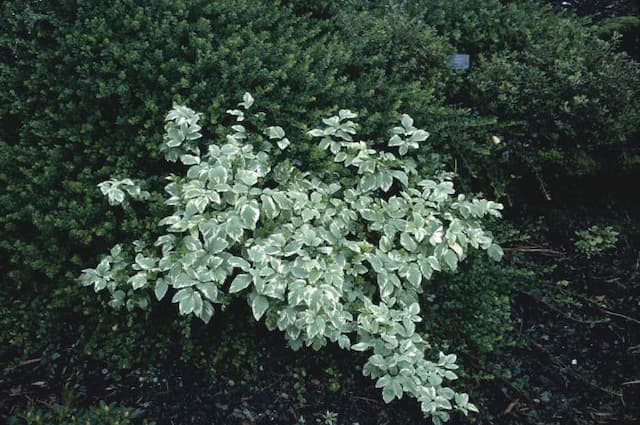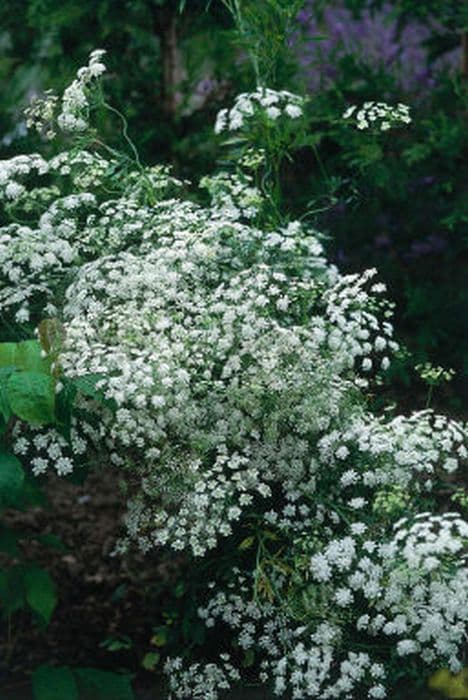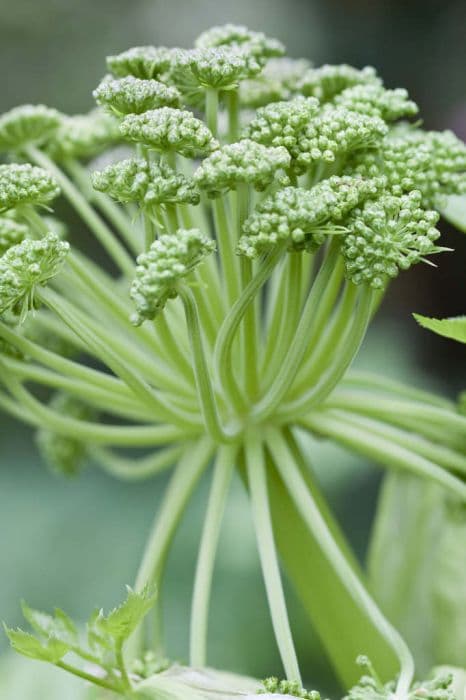Oliver's Eryngo Eryngium × oliverianum

ABOUT
Eryngium × oliverianum, commonly known as Miss Wilmott's ghost, is a unique and visually striking plant that boasts a distinctive appearance. It is characterized by its rosettes of spiky, lance-shaped leaves that create a textured and somewhat thorny base. The foliage is typically a bluish or silvery-green hue, adding a touch of muted color to gardens and landscapes. The most captivating feature of Miss Wilmott's ghost is its flower heads. These blooms are cone-shaped and surrounded by a ruff of spiny bracts. The flowers themselves are small and can range in color from blue to silver, with a metallic sheen that can appear almost otherworldly under the right lighting conditions. These blooms are tightly packed together at the tops of branching stems, giving the overall impression of an intricate, somewhat spiky, dome-shaped bouquet. As the plants mature, they develop a more pronounced silvery or white appearance, which is how the plant gained its common name, as it can evoke the ethereal image of a ghost in the garden. The contrast between the spiky texture of the leaves and bracts and the subtle coloration make Miss Wilmott's ghost a popular choice for adding structural interest and a touch of drama to ornamental planting schemes.
About this plant
 Names
NamesFamily
Apiaceae
Synonyms
Miss Willmott's Ghost
Common names
Eryngium oliverianum
 Toxicity
ToxicityTo humans
The plant Eryngium × oliverianum, commonly known as Miss Willmott's ghost, is not generally considered toxic to humans. There is no well-documented toxicity or consequences associated with the ingestion of this plant. However, as with any plant, individual allergic reactions or sensitivities are possible, and it's always advisable to exercise caution and avoid ingesting plants or plant parts unless they are known to be safe and are intended for culinary use.
To pets
Miss Willmott's ghost (Eryngium × oliverianum) is not known to be toxic to pets such as dogs and cats. There are no major symptoms of poisoning associated with this plant for pets. Nevertheless, pet owners should be aware that non-toxic plants can still cause gastrointestinal discomfort if ingested in large quantities or if the pet has a sensitive stomach. It is best to prevent pets from consuming non-food plants as a general safety precaution.
 Characteristics
CharacteristicsLife cycle
Perennials
Foliage type
Semi-deciduous
Color of leaves
Green
Flower color
Blue
Height
2 feet (60 cm)
Spread
1 foot (30 cm)
Plant type
Herb
Hardiness zones
5
Native area
Hybrid
Benefits
 General Benefits
General Benefits- Attracts pollinators: Eryngium × oliverianum, commonly known as Oliver's Eryngo, is known for attracting bees, butterflies, and other beneficial insects to the garden, promoting pollination of nearby plants.
- Drought resistance: As a hardy perennial, Oliver's Eryngo has good drought tolerance once established, reducing the need for frequent watering and making it suitable for xeriscaping.
- Low maintenance: Requiring minimal care once settled in the right environment, this plant suits gardeners who prefer low-maintenance landscapes.
- Architectural interest: With its striking spiny foliage and cone-like flowers, Oliver's Eryngo adds unique texture and a strong architectural element to garden designs.
- Long blooming season: The long-lasting flowers of Oliver's Eryngo provide color and interest in gardens for an extended period from mid-summer to fall.
- Cut and dried flower use: The blooms and seed heads are highly valued for use in both fresh and dried floral arrangements, offering versatility for decorators and florists.
- Deer and rabbit resistant: This plant is typically resistant to browsing by deer and rabbits, making it suitable for gardens where these animals are common pests.
- Erosion control: The root system of Oliver's Eryngo can help stabilize soil and control erosion on slopes or in areas with loose soil.
- Seaside suitability: Capable of withstanding coastal conditions, Oliver's Eryngo is suitable for seaside gardens, where it can tolerate salt sprays and sandy soils.
 Medical Properties
Medical PropertiesThis plant is not used for medical purposes.
 Air-purifying Qualities
Air-purifying QualitiesThis plant is not specifically known for air purifying qualities.
 Other Uses
Other Uses- Eryngium × oliverianum, commonly known as Sea Holly, can be used as a natural dye; the roots have historically been used to produce a blue dye that can be employed in textile coloring.
- The architectural form of Sea Holly makes it an excellent choice for dried flower arrangements, where its striking shapes and colors can be preserved.
- The spiny and structural nature of Sea Holly can be used as a protective barrier in gardens; planting them around sensitive areas can deter small animals and pests.
- Sea Holly can act as an ornamental feature in garden design, adding a silver to steel-blue coloration and distinctive texture to rock gardens or coastal-themed landscapes.
- The plant can be used in floral arrangements for weddings and events, offering a unique and modern aesthetic with its thistle-like appearance.
- Sea Holly could be used as a natural fencing option, creating a visually intriguing and impenetrable barrier due to its spiky foliage.
- In eco-friendly garden practices, Sea Holly serves as a beneficial attractant for pollinators like bees and butterflies, enhancing pollination in the garden.
- Sea Holly might be included in children's educational gardens to teach about plant defense mechanisms because of its prickly leaves and bracts.
- Using Sea Holly in coastal land management can help with soil stabilization, as its deep root system helps to bind sandy soils.
- Sea Holly's distinctive seed heads could be utilized in arts and crafts, providing material for creating natural decorative items or botanical jewelry.
Interesting Facts
 Feng Shui
Feng ShuiThe Sea Holly is not used in Feng Shui practice.
 Zodiac Sign Compitability
Zodiac Sign CompitabilityThe Sea Holly is not used in astrology practice.
 Plant Symbolism
Plant Symbolism- Determination: Eryngium × oliverianum, commonly known as Sea Holly, has a hardy nature and resilient growth habit, which often symbolizes a strong will and determination.
- Independence: The plant's ability to thrive in poor soils and resist drought reflects independence and self-sufficiency.
- Attraction: The striking appearance of Sea Holly with its spiky blue flowers and silvery-green foliage is said to represent attraction and allure, making it a symbol of fascination and intrigue.
- Protection: With its thistle-like appearance, Sea Holly metaphorically offers protection against negative forces and is often considered a symbol of defense.
 Water
WaterMiss Wilmott's Ghost should be watered once the top inch of soil feels dry, which typically translates to about once a week during active growing seasons like spring and summer, and less frequently during fall and winter. When watering, it is essential to soak the soil thoroughly until water runs out of the bottom of the pot, which might require around 16 to 24 ounces depending on the size of the pot and the plant. Avoid overhead watering which could damage the foliage; instead, water directly at the base of the plant. Be cautious of over-watering as this plant prefers drier conditions and is drought-tolerant once established.
 Light
LightMiss Wilmott's Ghost thrives in full sun conditions, meaning it should receive at least 6 hours of direct sunlight each day. The ideal spot for this plant would be in an area where sunlight is abundant and unfiltered by trees or buildings. However, it can tolerate partial shade, though flowering may be reduced in less than optimal light conditions.
 Temperature
TemperatureMiss Wilmott's Ghost grows best in temperatures between 60°F and 80°F but can tolerate a range from freezing up to 90°F. Avoid exposing the plant to prolonged temperatures below 25°F as this may damage or kill it. Consistently warm temperatures within the ideal range will ensure the best growth and flowering.
 Pruning
PruningPruning Miss Wilmott's Ghost is primarily done to remove faded flowers and to shape the plant. Deadheading, or the removal of spent blooms, encourages further flowering. Pruning can be done after the blooming period in late summer or early fall. It's not necessary to prune this plant heavily; light pruning each year is enough to maintain its shape and vigor.
 Cleaning
CleaningAs needed
 Soil
SoilMiss Willmott's Ghost (Eryngium × oliverianum) thrives in well-draining soil that is moderately fertile. A mixture of loam, coarse sand, and peat or compost will ensure good drainage and aeration. The ideal pH for this plant's soil is between 6.0 and 7.0.
 Repotting
RepottingMiss Willmott's Ghost, generally, should be repotted every two to three years. This is to refresh the soil and to accommodate the growth of the plant. It's best to repot in spring before the new growth begins.
 Humidity & Misting
Humidity & MistingMiss Willmott's Ghost does well in average humidity conditions. It does not have specific humidity requirements but can tolerate a dry atmosphere. Avoid overly humid conditions, as this could encourage fungal issues.
 Suitable locations
Suitable locationsIndoor
Place Miss Willmott's Ghost in full light, well-draining soil.
Outdoor
Plant in full sun, well-drained soil; tolerate drought.
Hardiness zone
5-9 USDA
 Life cycle
Life cycleEryngium × oliverianum, commonly known as Oliver's eryngo, begins its life cycle as a seed, which germinates in spring under suitable temperature and moisture conditions. The seedling stage follows, where the plant establishes its root system and foliage begins to develop. Throughout the growing season, it enters the vegetative stage, in which the plant grows actively and the distinctive foliage and stem structure characteristic of the genus becomes apparent. As it matures, Oliver's eryngo enters the flowering stage, typically in the summer, producing striking steel-blue to amethyst flower heads that attract various pollinators. After pollination, the plant sets seed and the lifecycle can begin anew, while the existing plant may either die back if it is an annual or biennial or enter a period of dormancy if it is a perennial. In the case of perennials, the following spring heralds a new cycle of growth and reproduction.
 Propogation
PropogationPropogation time
Early Spring
Eryngium × oliverianum, more commonly known as Miss Wilmott's ghost, is typically propagated through its seeds. The best time for sowing the seeds is in late winter or early spring. For successful propagation, the seeds should be distributed on the surface of a well-draining seed starting mix and then lightly covered with soil. The container should then be placed in a cold frame or a similarly sheltered outdoor location to undergo stratification, which is a period of cold exposure needed to break the seed's dormancy. Keeping the soil consistently moist during germination is crucial. Seedlings usually emerge when temperatures start to rise in spring. It is important to avoid disturbing the taproot when transplanting young seedlings.









